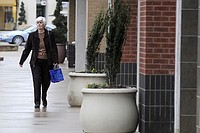NORTHWEST ARKANSAS — Pinnacle Hills Promenade retailers are seeing more traffic and higher sales.
“We’re on an upward spiral. I think people are just ready to spend more,” said Brenda Majors, the mall’s marketing manager.
She said some of the mall’s retailers report double digit sales increases the past several months compared to a year ago.
This is the trend retailers across the country are hoping to follow.
Experts predict 2011 to show slight growth in the retail sector, improving as the year goes on.
Early sales numbers show slow but steady gains. January retail sales increased 0.2 percent from December and 3.5 percent year-over-year, the National Retail Federation reports. This marks the seventh straight month of higher sales.
“In 2011 retailers start to emerge as the job market gains traction, but strong gains won’t be seen until 2012,” said Frank Badillo, vice president and senior retail economist with Kantar Retail.
Deborah Weinswig, retail analyst for Citi Investment Research, also expects to see moderate recovery this year.
“We all feel a little bit better,” she said. “We are starting to see people open their wallets a bit more.”
Weinswig categorizes consumer spending to an hourglass. Retailers at the top of the hourglass have shoppers facing low unemployment and improving confidence. They include high-end department stores, upscalesupermarkets and luxury goods retailers who benefit by catering to the high-end recovery.
Shoppers at the bottom face unemployment, rising food stamp usage and a lack of credit, she said. Retailers here include discounters, dollar stores and warehouse clubs and benefi t as low-income consumers keep a tight budget.
Challenges remain for consumers in the bottom of the hourglass, Weinswig said. They are buying in bulk at the beginning of the month and trading down to single pack sizes as money runs low at the end of the month.
Retailers in the middle are being squeezed as shoppers trade up and down, she said. These retailers include department stores such as Kohls, drug stores, teen retailers and traditional supermarkets.
Conditions should improve across all levels as consumer confidence strengthens. Kathy Deck, director for the Center for Business and Economic Research at the University of Arkansas, said that will continue to occur as the employment situation improves.
“That has a stabilizing effect on the whole economy,” she said.
The unemployment rate is falling nationally, dropping to 9 percent in January. It was 9.4 percent in December, according to the Bureau of Labor Statistics.
The local unemployment rate was 6. 2 percent in December, slightly up from the 5.8 percent mark in November.
Deck said the area is poised to gain 2,000 to 5,000 jobs across all sectors this year after losing more than 3,000 jobs in 2010.
Jeff Bishop, Northwest Arkansas Mall senior property manager, said jobs are needed to drive discretionary spending.
He said the mall’s traff c picked up before Christmas and has remained steady. Overall sales volume in 2010 beat 2009, and he said if trends continue this year will be even better.
Shopper Profile
Shopper habits changed during the recession that started in December 2007. Though the recession officially ended in June 2009, its eftects are ongoing and created what Weinswig calls the “new abnormal.”
“We have a dift erent type of consumer,” she said. “The same shopper is going to Saks and to the Dollar Store.”
She described the new shopper as someone who trades down on essentials in order to splurge on discretionary purchases, swinging between saving and spending.
These consumers will alsospend money on small luxuries to escape from diff cult economic realities.
James Russo, vice president of Global Consumer Insights for The Nielsen Company, agrees shopping habits have changed.
“Consumers have moved off the sidelines and are back in the game; a very different game,” he said. “Now they are looking for value.”
Value seekers are not just motivated by price, but a balance between price and benefi ts.
They want to get the biggest bang for their buck.
These shoppers tend to be less loyal to specifi c retailers and are willing to switch, Russo said.
Gas prices also play a role in where and how often some consumers shop.
Deck said gas in the $3 a gallon range squeezes lower and middle income shoppers, but when the price approaches $4 a gallon you see a broader impact.
“They might make fewer trips or buy more on each trip. They may have to alter what they buy,” she said.
Shopper trips were closely monitored in 2010, and will be again this year, Russo said.
“Right now we are not seeing significant growth in shopper trips or in transaction size,” he said.
Households earning more than $100,000 - about 17 percent of U.S. households - increased shopping trips by about 5 percent in recent months. All other households have decreased trips by 4 percent.
Meanwhile, the top 20 percent of income earners account for 38 percent of total spending and 50 percent of discretionary spending in the U.S., Weinswig said.
Business, Pages 9 on 02/20/2011

